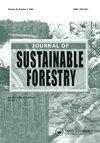导致热带山区森林退化的因素:以印度尼西亚Mutis-Timau森林综合体为例
IF 1.8
4区 农林科学
Q3 FORESTRY
引用次数: 0
摘要
Mutis-Timau森林复合体是印度尼西亚东部帝汶岛仅存的山地热带林区之一,已遭受严重的森林砍伐和森林退化。许多研究都强调了影响森林砍伐的因素。然而,在局部范围内,关于影响森林退化因素的信息仍然有限。为了弥补这一差距,我们使用空间统计方法分析了1999-2017年期间Mutis-Timau森林复群的森林退化因素。我们以森林冠层密度时间序列图中获得的森林退化数据作为因变量,以影响森林退化的因素(即到居民点的距离、到道路的距离、到农业的距离、到河流的距离、到稀树草原的距离、到森林边缘的距离、坡度、海拔、人口密度和森林经营单位)作为自变量的空间表示进行logistic回归。研究结果表明,距离森林边缘和海拔的增加会降低森林退化的可能性,而远离河流和聚落的森林则会增加森林退化的可能性。这些调查结果对于森林当局确定防治森林退化的行动的优先次序、设计适当的与森林有关的政策和支助减少森林退化所产生的碳排放的数据或减少森林退化的其他奖励办法都很重要。本文章由计算机程序翻译,如有差异,请以英文原文为准。
Factors Contributing to Forest Degradation in the Mountainous Tropical Forest: A Case Study of the Mutis-Timau Forest Complex, Indonesia
ABSTRACT The Mutis-Timau Forest Complex, one of the remaining mountainous tropical forest areas in Timor Island, eastern Indonesia, has been exposed to significant deforestation and forest degradation. Numerous studies have highlighted the factors affecting deforestation. However, information about the factors influencing forest degradation at the local scope is still limited. To address this gap, we analyzed the factors contributing to forest degradation during the 1999–2017 period in the Mutis-Timau Forest Complex using a spatial statistical approach. We developed logistic regression using the forest degradation data obtained from forest canopy density time series maps as dependent variables and the spatial representation of the factors contributing to forest degradation, namely distance to the settlement, distance to the road, distance to agriculture, distance to the river, distance to the savanna, distance to the forest edge, slope, elevation, population density, and forest management unit, as independent variables. Our finding showed the increase in distance to the forest edge and elevation would decrease the likelihood of forest degradation, whereas the probability of forest degradation increases in forest located far from the river and the settlement. Such findings are important for the forest authority in prioritizing actions for combating forest degradation and designing appropriate forest-related policies and supporting data for reducing carbon emissions from forest degradation implementation or other incentive schemes in reducing forest degradation.
求助全文
通过发布文献求助,成功后即可免费获取论文全文。
去求助
来源期刊

Journal of Sustainable Forestry
Social Sciences-Geography, Planning and Development
CiteScore
3.90
自引率
12.50%
发文量
42
期刊介绍:
Journal of Sustainable Forestry publishes peer-reviewed, original research on forest science. While the emphasis is on sustainable use of forest products and services, the journal covers a wide range of topics from the underlying biology and ecology of forests to the social, economic and policy aspects of forestry. Short communications and review papers that provide a clear theoretical, conceptual or methodological contribution to the existing literature are also included in the journal.
Common topics covered in the Journal of Sustainable Forestry include:
• Ecology, management, recreation, restoration and silvicultural systems of all forest types, including urban forests
• All aspects of forest biology, including ecophysiology, entomology, pathology, genetics, tree breeding, and biotechnology
• Wood properties, forest biomass, bioenergy, and carbon sequestration
• Simulation modeling, inventory, quantitative methods, and remote sensing
• Environmental pollution, fire and climate change impacts, and adaptation and mitigation in forests
• Forest engineering, economics, human dimensions, natural resource policy, and planning
Journal of Sustainable Forestry provides an international forum for dialogue between research scientists, forest managers, economists and policy and decision makers who share the common vision of the sustainable use of natural resources.
 求助内容:
求助内容: 应助结果提醒方式:
应助结果提醒方式:


